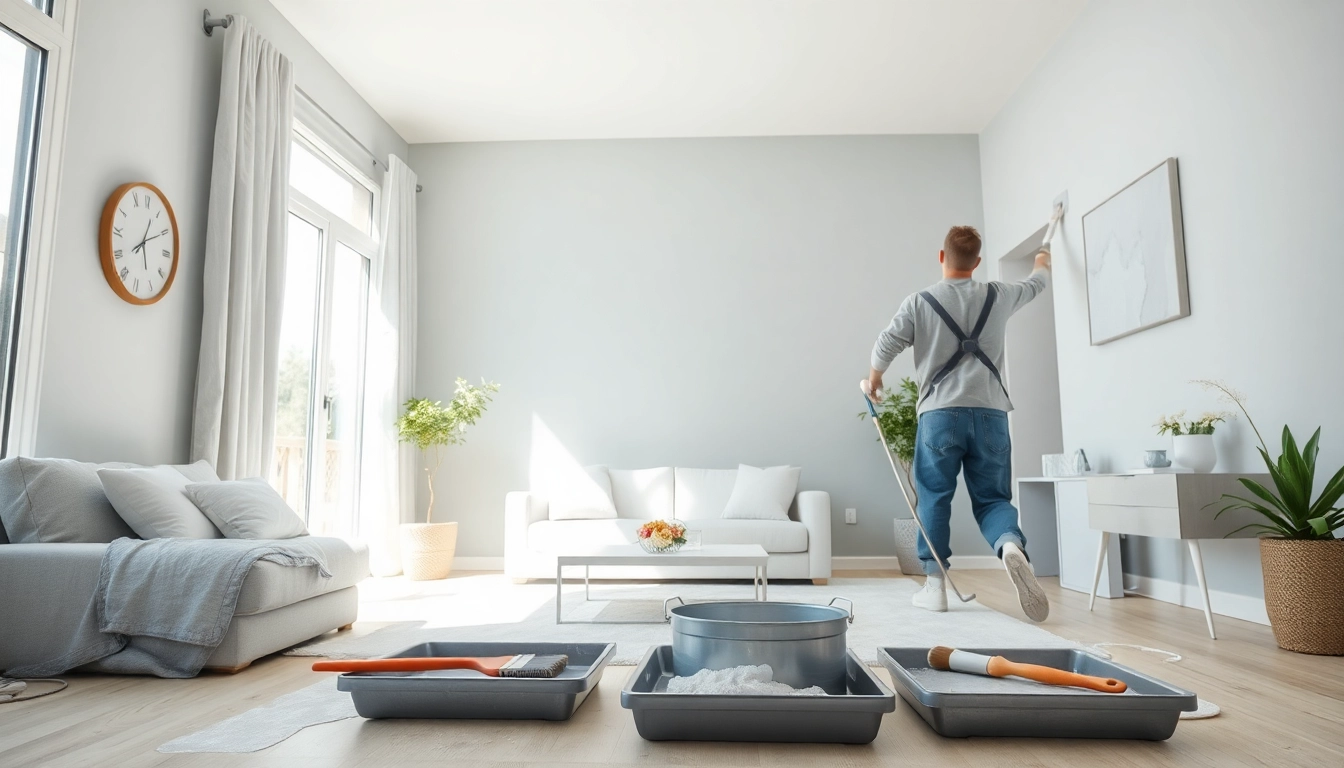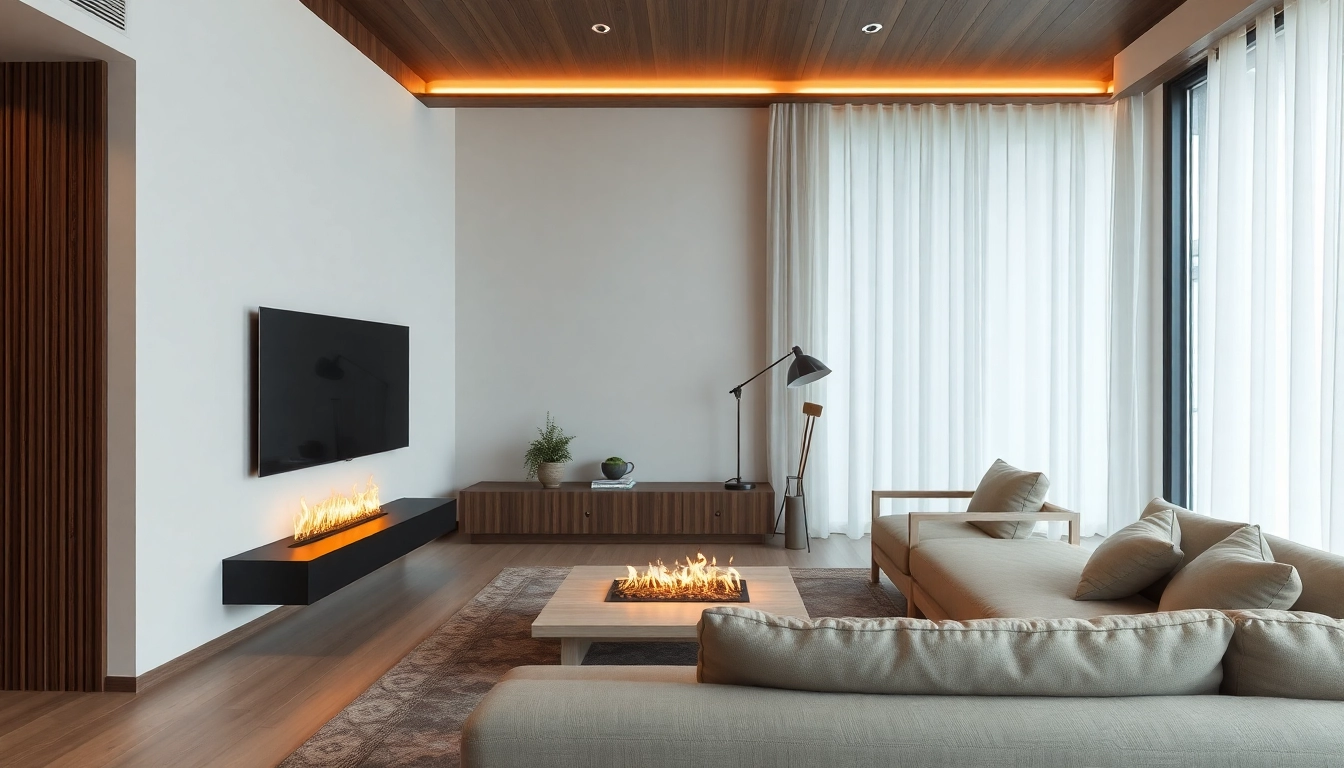Understanding Interior Painting Basics
What is Interior Painting?
Interior painting is more than just applying color to walls; it’s a transformative process that elevates the overall aesthetic of a living space. This involves preparing surfaces, selecting the right paint, and employing techniques that ensure both durability and an attractive finish. Suitable for any type of room, interior painting can affect how a space feels and functions, thus making it essential for homeowners looking to refresh their surroundings.
Types of Paint and Their Uses
When embarking on an interior painting project, understanding the types of paint available is crucial for achieving desired results. Generally, paint is categorized into two primary types: latex (water-based) and oil-based paints.
- Latex Paint: Water-based and known for its easy cleanup, rapid drying time, and durability. Ideal for walls and ceilings, latex paints maintain color retention well and are less prone to fading over time.
- Oil-Based Paint: Known for its high gloss and superior durability, oil-based paint is suitable for areas that require a harder finish, such as trim and moldings. However, it can be more challenging to work with and requires solvents for cleanup.
Additionally, paint finishes come in several varieties, including matte, eggshell, satin, semi-gloss, and gloss. The choice of finish significantly influences the appearance of the final application.
Tools Essential for Interior Painting
A successful interior painting project requires the right tools. Below is a list of essential painting tools that can make your job more efficient:
- Paint Rollers: Ideal for larger wall areas, rollers apply paint evenly.
- Brushes: Essential for edging and touch-ups, with varying sizes for precision work.
- Paint Tray: Holds paint for easy access while rolling.
- Drop Cloths: Protects floors and furniture from spills.
- Painter’s Tape: Helps achieve crisp paint lines and clean edges.
- Ladder or Step Stool: Ensures you can reach higher areas safely.
Planning Your Interior Painting Project
Choosing the Right Colors
Selecting the right color is one of the most impactful decisions in interior painting. The psychological effects of color can influence mood and interaction within a space. Neutrals create calmness, while bold colors invigorate energy. Here are a few tips for choosing the perfect palette:
- Consider the function of the room; for example, soft blues can promote relaxation in bedrooms, while lively yellows may enhance creativity in a home office.
- Test colors on your walls with samples to see how they interact with lighting throughout the day.
- Remember to consider how colors coordinate with your existing furniture and decor.
Estimating Costs for Interior Painting
The costs of interior painting can vary significantly based on the size of the space, the quality of paint chosen, and whether you hire professionals or tackle the job yourself. On average, homeowners can expect to pay between $1,800 and $10,000 for a full interior painting job.
Factors influencing these costs include:
- Room dimensions and layout
- Surface preparation needs, such as patching and priming
- The chosen paint brand and finish
- Labor rates if hiring professionals
For a detailed insight into cost breakdowns, understanding local market rates through research or online resources, such as interior painting cost calculators, can be beneficial.
Creating a Timeline for Completion
A well-structured timeline can help maintain a steady flow in your painting project. Start by assessing how long each phase will take—including preparation, painting the walls, and final touch-ups—and plan accordingly. For smaller rooms, a few days may suffice, but larger projects could span up to a week or more depending on the complexity.
Techniques for Successful Interior Painting
Best Practices for Applying Paint
To achieve a professional finish, implementing best practices during the painting process is essential:
- Always start with ceilings, then walls, followed by trim and baseboards.
- Use long, even strokes with rollers for walls; for brushes, use a stippling technique to blend edges.
- Allow ample drying time between coats to avoid uneven textures.
- Apply paint in natural light for the best visibility of coverage and color uniformity.
How to Prepare Your Space for Painting
Preparation is key to ensuring a successful painting experience. Here are steps to follow:
- Clear the room of furniture or move items to the center, covering them with drop cloths.
- Repair any wall imperfections and properly clean the surfaces before painting.
- Apply painter’s tape on edges to ensure clean lines.
- Ventilate the area well to dissipate fumes and expedite drying.
Common Mistakes to Avoid in Interior Painting
Even seasoned painters can fall into traps that compromise the quality of their work. Avoid the following common pitfalls:
- Skipping primer: This can lead to uneven color and paint adhesion.
- Using low-quality paint: While it might save money initially, it can lead to frequent reapplications.
- Inadequate mixing of paint cans: Ensures color consistency across the project.
- Ignoring temperature and humidity: These environmental factors can greatly affect paint application and drying times.
Hiring Professionals vs. DIY Interior Painting
Benefits of Hiring Interior Painting Professionals
Enlisting a professional painting service can save time and guarantee high-quality results. Here are some benefits associated with hiring experts:
- Expertise: Professionals often have experience handling difficult spaces and use advanced techniques.
- Quality Tools: They have access to high-grade materials and efficient tools that improve the painting process.
- Warranty and Insurance: Professional services usually come with guarantees and cover damages if they occur during the project.
- Time-Saving: Professionals can complete the work quickl, freeing up your schedule for other priorities.
When to Consider DIY Painting
While hiring a professional has undeniable advantages, there are scenarios where DIY interior painting may be more suitable. Consider the following:
- Your budget constraints might not allow for professional services.
- I’ms you have a small area to paint—such as a bathroom or laundry room—where you can handle the tasks easily.
- If you enjoy crafting and personalizing spaces, embracing DIY could be rewarding and fun.
Finding Reliable Painters Near You
When deciding to hire professionals, it’s crucial to vet potential painters thoroughly. Start by seeking recommendations from friends or family or exploring online platforms for reviews and ratings. Checking credentials, insurance, and previous project portfolios ensures you make an informed choice.
Staying Sustainable with Your Interior Painting Choices
Eco-Friendly Paint Options
As the focus on sustainability grows, eco-friendly paints have gained popularity among consumers. These paints typically contain lower volatile organic compounds (VOCs) and fewer toxic substances than traditional paints. Brands like Benjamin Moore and Sherwin-Williams offer lines of low- or zero-VOC paint that maintain quality and performance while being kinder to the environment.
Reducing Waste During Your Painting Project
Minimizing waste is essential in any painting project. Here are several strategies:
- Estimate the amount of paint needed effectively to avoid excess.
- Recycle used paint cans and safely dispose of unused or expired paints at designated facilities.
- Use drop cloths that can be reused rather than disposable coverings to protect floors and furniture.
Long-Term Maintenance Tips for Painted Interiors
Maintaining your newly painted walls is crucial for prolonging aesthetic quality. Here are some long-term care tips:
- Regularly dust surfaces to prevent dirt accumulation.
- Clean walls with a damp cloth without harsh chemicals that can wear down paint over time.
- Address damage promptly to avoid larger repair needs.



